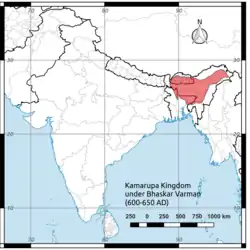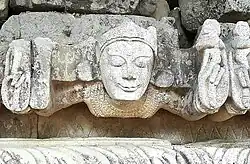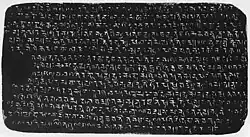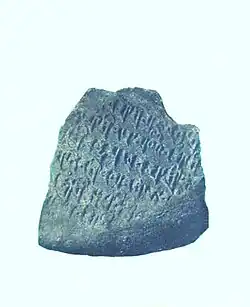Bhaskaravarman
| Bhaskaravarman | |
|---|---|
 The 7th century Kamarupa under Bhaskaravarman.[1] The kingdom extended to the east up to the hills that led to China,[2] according to the Chinese pilgrim Hiuen Tsang who visited Bhaskarbarman's court during his heydays around 643 CE. | |
| King of Kamarupa | |
| Reign | 600–650 CE |
| Part of a series on the |
| History of Assam |
|---|
 |
| Categories |
|
Bhaskaravarman (600–650 CE) was king of Kamarupa and the last ruler of the Varman dynasty. He restored Varman rule after his father, Susthitavarman, was defeated and allied with Harshavardhana of Thaneswar against Gauda and East Malwa.[3][4] He was visited by Chinese envoys Xuanzang and Wang Xuance.[5][6]
Background
Bhaskaravarman succeeded his brother Supratisthitavarman and was the first Kamarupa king to claim descent from Narakasura, Bhagadatta, and Vajradatta.[7][8] He issued the Dubi and Nidhanpur copper plate grants,[9] and a clay seal with his name was found at Nalanda.[10]
After Susthitavarman’s defeat by Mahasenagupta, Supratisthitavarman briefly ruled but died without an heir. Bhaskaravarman then took the throne around 600 CE.[11]
Rivals
Mahasenagupta allied with Shashanka and controlled north and central Bengal after defeating Susthitavarman.[12] After Mahasenagupta's death, Shashanka ruled Bengal. Bhaskaravarman's main rivals were Shashanka and Prabhakaravardhana, father of Harshavardhana.[4]
Alliance with Harsha
After Shashanka murdered Rajyavardhana, Harshavardhana’s brother and successor, Bhaskaravarman sent envoy Hangsavega to Thaneswar to form an alliance. This is recorded by Bana and Xuanzang.[13][14]
Chinese accounts
Xuanzang's account
| Part of a series on the |
| History of Kamarupa |
|---|
 |
| Ruling dynasties |
Chinese pilgrim Xuanzang visited Bhaskaravarman’s court around 643 CE and described the capital's circumference as thirty li (~9 miles). He described Bhaskaravarman as a Brahmana who patronized Buddhism, though he was not a Buddhist himself.[15] This contrasts with the She-Kia-Fang-Che which calls Bhaskaravarman a Kshatriya of Chinese ancestry.[16]
Wang Xuance's account
After 648 CE, envoy Wang Xuance visited Harshavardhana’s court but was expelled by Yashovarman. Wang returned with an army, captured Yashovarman, and brought him to China. Bhaskaravarman aided Wang with supplies.[12] Chinese records call Bhaskaravarman Ch-Kieu-mo (Sri-Kumara) and Kamarupa Kia-mu-lu. He gave Wang a map and requested an image of Laozi.[17]
Kamarupa of Bhaskaravarman
Xuanzang, in his travelogue, noted that he crossed the river Karatoya before entering Kamarupa. The eastern boundary was a line of hills close to the Chinese frontier. He also said that Kamarupa was nearly 1,700 miles in circumference. The climate was genial. He mentioned that the people were of short height and yellow complexion, and Bhaskaravarman was Hindu and not Buddhist. The people's speech differed little from that of Central India. They were of violent disposition but also persevering students. They worshipped the Devas and didn't believe in Buddhism. The Deva-temples were some hundreds in number, and the various systems had some myriads of professed adherents. The few Buddhists in the country performed their acts of devotion in secret. The pilgrim heard from the locals that to the east of the country was a series of hills which reached as far as the confines of China. The inhabitants of these hills were akin to the "Man of the Lao". In the southeast of the country, elephants were plentiful.[18]
Description
Xuanzang notes that Kamarupa was low and moist and that the crops were regular. Coconuts and jackfruits grew abundantly and were appreciated by the people. The description provided is around present-day Guwahati.[19]
According to the account given in the Si-yu-ki, the circumference of Kamarupa was about 1,700 miles (2,700 km). As Edward Albert Gait has pointed out, this circumference must have included the whole of the Assam valley, Surma valley, parts of North Bengal, and parts of Mymensingh.[20]
Religion
Bhaskaravarman was primarily a worshiper of Shiva but showed respect towards Buddhist monks and scholars, reflecting an inclination towards Buddhism.[21] The general populace worshipped various Devas in temples, while Buddhist followers often practiced devotion secretly.[22]
Culture
During Bhaskaravarman’s reign, Kamarupa saw cultural and intellectual growth, supported by his patronage and diplomatic ties with Harshavardhana.[23] The Nidhanpur copper plate grant from Karnasuvarna includes unique local literary forms not seen in later inscriptions.[24]
Art and industry
Bhaskaravarman’s gifts to Harshavardhana included land products such as a royal umbrella studded with gems, puthis on sachi-bark, cane mats, agar essence, musk, molasses, utensils, paintings, and silk fabrics, reflecting the rudimentary local industry.[25][26]
Nidhanpur inscription

The Nidhanpur copper plate praises Bhaskaravarman as a ruler who dispelled the darkness of the Kali age, upheld Arya religion with his revenues, matched the strength of his vassals militarily, and improved the welfare of loyal subjects through steadiness and modesty. He is metaphorically adorned with fame from defeated kings’ praises and compared to legendary figures for charity and wisdom. He is described as learned, brave, patient, strong, and righteous.[27]
Nalanda seal

Bhaskaravarman’s seal, dated 643 CE, was discovered at Nalanda with seals of Harshavardhana during 1917–18 excavations. The inscription lists royal names and may have accompanied an invitation to Xuanzang.[28] The presence of both kings’ seals suggests they visited Nalanda and left their marks.[12]
Sri Ganapati Varma Sri Yajnavatyam Sri Mahendra Varma.
Sri Suvratayam Sri Narayanavarma Sri Devavatyam Sri Mahabhuta Varman.
Sri Vijnana Vatyam Sri Chandramukha Varman Sri Bhogavatyam.
Sri Sthitavarma tena Sri Nayana Sobhayam (Sri Susthitavarman)
(Sri Syama Lakshmyam) Sri Supratisthita Varman.
Sri Bhaskara Varmeti.
K.N. Dikshit, in his "Epigraphical notes of the Nalanda finds", proposes that the seal probably accompanied Bhaskaravarman's letter to Śīlabhadra inviting Xuanzang.[29] Bhaskaravarman's seal was found in the company of the two Harsha seals. It is likely that both Harsha and Bhaskaravarman were on the move from Rajmahal to Kanauj, merely to visit the university of Nalanda, and besides being together with the Chinese pilgrim, commemorate their visits previously, and by that, it is only to leave their respective seals at the university.[30]
Death
The date and circumstances of Bhaskaravarman’s death are unknown; his reign likely ended around 650 CE.
Post-death events
Historian Kanaklal Barua suggests a revolt by the Mlechhas after Bhaskaravarman’s death, leading Salastambha to seize the throne from his successor Avantivarman.[12]
Legacy
Kumar Bhaskar Varma Sanskrit and Ancient Studies University in Nalbari, Assam, is named after him.
See also
Notes
- ^ (Dutta 2008:282), reproduced from (Acharya 1968).
- ^ "He travelled from Pun-na-fa-tan-na (Pundravardhana) on the east more than 900 li or 150 miles; crossed a large river and reached Kia-no-leu-po (Kamarupa). The T'ang Shu refers to this large river as Ka-lo-tu, which undoubtedly meant the Karatoya. The pilgrim further states that to the east of the country was a series of hills which reached as far as the confines of China." (Baruah 1986:75)
- ^ Sen, Sailendra Nath (2013). A Textbook of Medieval Indian History. Primus Books. p. 39. ISBN 978-9380607344.
- ^ a b Baruah 1986.
- ^ Beal, Samuel (1884). Si-Yu-Ki: Buddhist Records of the Western World (Vol. II). Trubner & Co. p. 196.
- ^ Dikshit, K.N. (1922). "Epigraphical Notes of the Nalanda Finds". Epigraphia Indica. 12: 78–80.
- ^ Sharma, Mukunda Madhava (1978). Inscriptions of Ancient Assam. Gauhati University. p. xiv.
- ^ "Bhaskaravarman, Bhāskaravarman: 3 definitions". Wisdom Library. 21 January 2021. Retrieved 26 July 2025.
- ^ Sharma, Mukunda Madhava (1978). Inscriptions of Ancient Assam. Gauhati University.
- ^ Dikshit, K.N. (1922). "Epigraphical Notes of the Nalanda Finds". Epigraphia Indica. 12: 78–80.
- ^ Gait 1906, pp. 53–55.
- ^ a b c d Barua 1933.
- ^ Sircar, D.C. (1990). Barpujari, H.K. (ed.). Political History. Vol. 1. Publication Board Assam. pp. 94–171.
{{cite book}}:|work=ignored (help) - ^ Beal, Samuel (1884). Si-Yu-Ki.
- ^ Beal, Samuel (1884). Si-Yu-Ki. p. 196.
- ^ Sharma, Mukunda Madhava (1978). Inscriptions of Ancient Assam. Gauhati University. p. xiv.
- ^ Ghosh, Suchandra (2012). "Karnasuvarna". Banglapedia. Asiatic Society of Bangladesh. Retrieved 26 July 2025.
- ^ (Gait 1926:23–24)
- ^ Beal, Samuel (1884). Si-Yu-Ki: Buddhist Records of the Western World. Vol. II. Trubner & Co. p. 196.
- ^ Gait 1906, pp. 23–24.
- ^ https://archive.org/details/siyukibuddhistre02bealuoft/page/196/mode/2up
- ^ https://books.google.com/books?id=ekf7v9yJ6k4C&pg=PA45
- ^ "Wakhal Nachom". 2006.
- ^ https://www.jstor.org/stable/44143290
- ^ "Wakhal Nachom". 2006.
- ^ https://books.google.com/books?id=L7iV6DwAuQAC&pg=PA67
- ^ Sharma, Mukunda Madhava (1978). Inscriptions of Ancient Assam. Gauhati University.
- ^ Dikshit, K.N. (1922). "Epigraphical Notes of the Nalanda Finds." Epigraphia Indica, Vol. XII.
- ^ ibid.
- ^ Barua 1933, p. 98.
References
- Acharya, N. N. (1968), Asama Aitihashik Bhuchitravali (Maps of Ancient Assam), Bina Library, Gauhati, Assam
- Barua, Kanak Lal (1933). Early History Of Kamarupa.
- Baruah, S L (1986), A Comprehensive History of Assam, New Delhi: Munshiram Manoharlal Publishers Pvt Ltd
- Beal, Samuel (1884). Si-Yu-Ki. Buddhist Records of the Western World, Translated from the Chinese of Hsüan-tsang (A.D. 629). Vol. II. London: Trubner & Co. Retrieved 17 February 2013.
- Dutta, Anima (2008). Political geography of Pragjyotisa Kamarupa (PhD). Gauhati University. hdl:10603/68309.
- Gait, E A (1906), A History of Assam, Thacker, Spink and Co., Calcutta
- Gait, Sir Edward (1926), A History of Assam, Lawyer's Book Stall, Guwahati
- Ghosh, Suchandra (2012). "Karnasuvarna". In Islam, Sirajul; Jamal, Ahmed A. (eds.). Banglapedia: National Encyclopedia of Bangladesh (Second ed.). Asiatic Society of Bangladesh.
- Sircar, D C (1990b), "Political History", in Barpujari, H K (ed.), The Comprehensive History of Assam, vol. I, Guwahati: Publication Board, Assam, pp. 94–171
- Kāmarūpa-Kaliṅga-Mithilā:a politico-cultural alignment in Eastern India : history, art, traditions by Chandra Dhar Tripathi, Indian Institute of Advanced Study
- Sharma, Mukunda Madhava (1978). Inscriptions of Ancient Assam. Gauhati University, Assam.